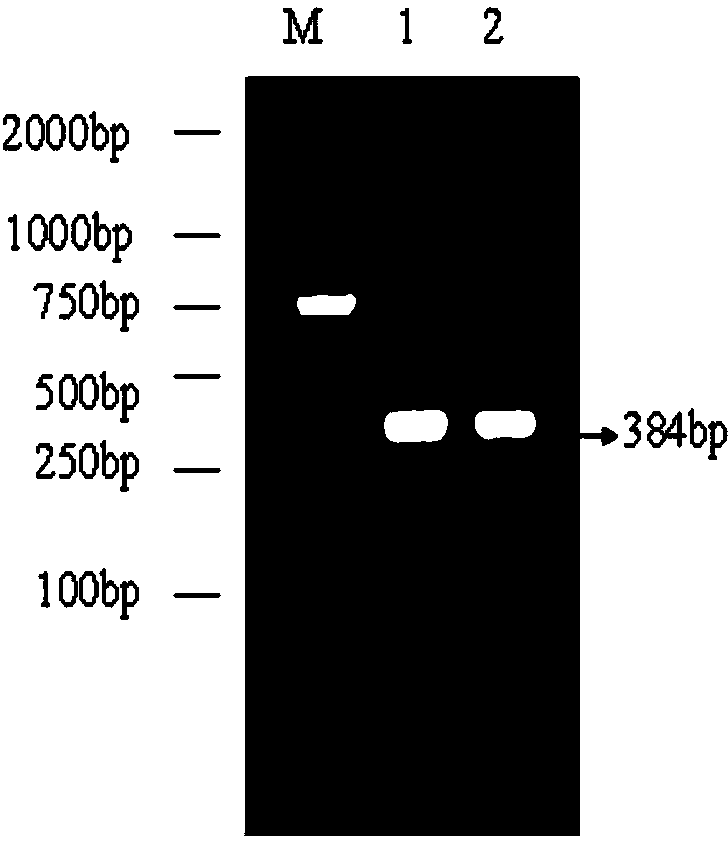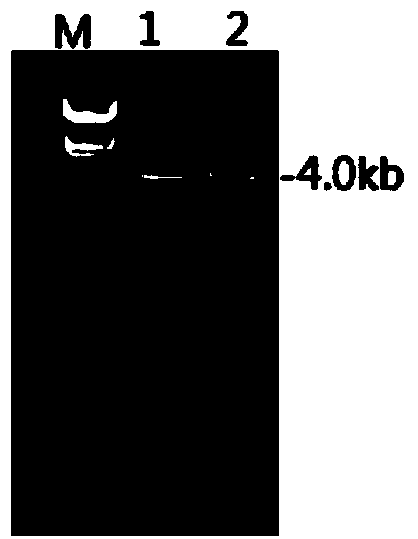Salmonella enteritidis double knockout attenuated mutant and preparation as well as application thereof
A Salmonella enteritidis, gene knockout technology, applied in the field of microbiology, can solve the problem of bacterial drug resistance and drug residues
- Summary
- Abstract
- Description
- Claims
- Application Information
AI Technical Summary
Problems solved by technology
Method used
Image
Examples
Embodiment 1
[0077] Construction of C50041 Gene Mutant Strain
[0078] Source of C50041: China Medical Microbiology Culture Collection Management Center, preservation number CMCC50041
[0079] 1. Identification of C50041:
[0080] 1.1. Bacteria identification
[0081] 1.1.1 Staining Microscopic Examination After Gram staining, observe the shape of the bacteria and measure the size of the bacteria under an ordinary optical microscope. The results of Gram staining showed that microscopic examination could observe scattered arrangement of red short bacilli, the size of which was about 1 μm×4 μm.
[0082] 1.1.2 Biochemical test
[0083] Pick a purely cultured single colony and inoculate it into a biochemical identification tube, and observe the results after incubating at 37°C for 24 hours.
[0084] 2. Construction of C50041 gene mutant strain
[0085] 2.1 Target gene sequence determination
[0086] 2.1.1 Amplification of target genes
[0087] According to the Salmonella genome sequence...
Embodiment 2
[0143] Safety test: Lethality test of 1-day-old Hy-Line white chicks
[0144] Comparison of the virulence of the △C50041 (crp, spiC / Km) mutant strain prepared in Example 1 and the wild strain C50041 (CMCC: 50041)
[0145] Bacterial culture: Bacteria were cultured on LB plates at 37°C for 24 hours, picked 10 plump single colonies and streaked on the whole plate, cultured at 37°C for 5 hours, scraped the bacteria on LB plates with sterilized PBS Next, the bacterial concentration was adjusted to 10 9 CFU / ml.
[0146] One-day-old Hy-Line white chicks were randomly divided into 10 groups, 5 groups for each strain, and 14 chickens in each group. Set the concentration to 10 9 The bacterial solution of CFU / ml was diluted into 5 dilutions with sterilized PBS, and each chicken was intramuscularly injected with 0.1ml bacterial suspension, and the death situation was observed within two weeks, and the mortality rate was calculated. The test results showed that the virulence of the ΔC5...
Embodiment 3
[0149] C50041 and △C50041 (crp, ΔspiC / Km) were treated with 10 7 Bacterial amount of CFU was inoculated by intramuscular injection, and the experimental chickens were slaughtered in each group on 1d, 4d, 7d, 10d, 13d, 16d, 20d, 24d, and 28d after infection, and the spleen and part of the liver were aseptically collected, and the bacteria were counted. Changes in the number of bacteria in chicken liver Figure 16 , the change rule of the number of bacteria in the spleen see Figure 17 . The wild-type C50041 infection group all died 6 days after inoculation, but within a detectable time point, the amount of bacteria carried in the liver and spleen was significantly higher than that of the mutant bacteria, and the mutant bacteria were finally completely cleared in the liver and spleen, and in the liver In , mutants were undetectable at day 10 post-infection and in spleen at day 13.
PUM
 Login to View More
Login to View More Abstract
Description
Claims
Application Information
 Login to View More
Login to View More - R&D
- Intellectual Property
- Life Sciences
- Materials
- Tech Scout
- Unparalleled Data Quality
- Higher Quality Content
- 60% Fewer Hallucinations
Browse by: Latest US Patents, China's latest patents, Technical Efficacy Thesaurus, Application Domain, Technology Topic, Popular Technical Reports.
© 2025 PatSnap. All rights reserved.Legal|Privacy policy|Modern Slavery Act Transparency Statement|Sitemap|About US| Contact US: help@patsnap.com



